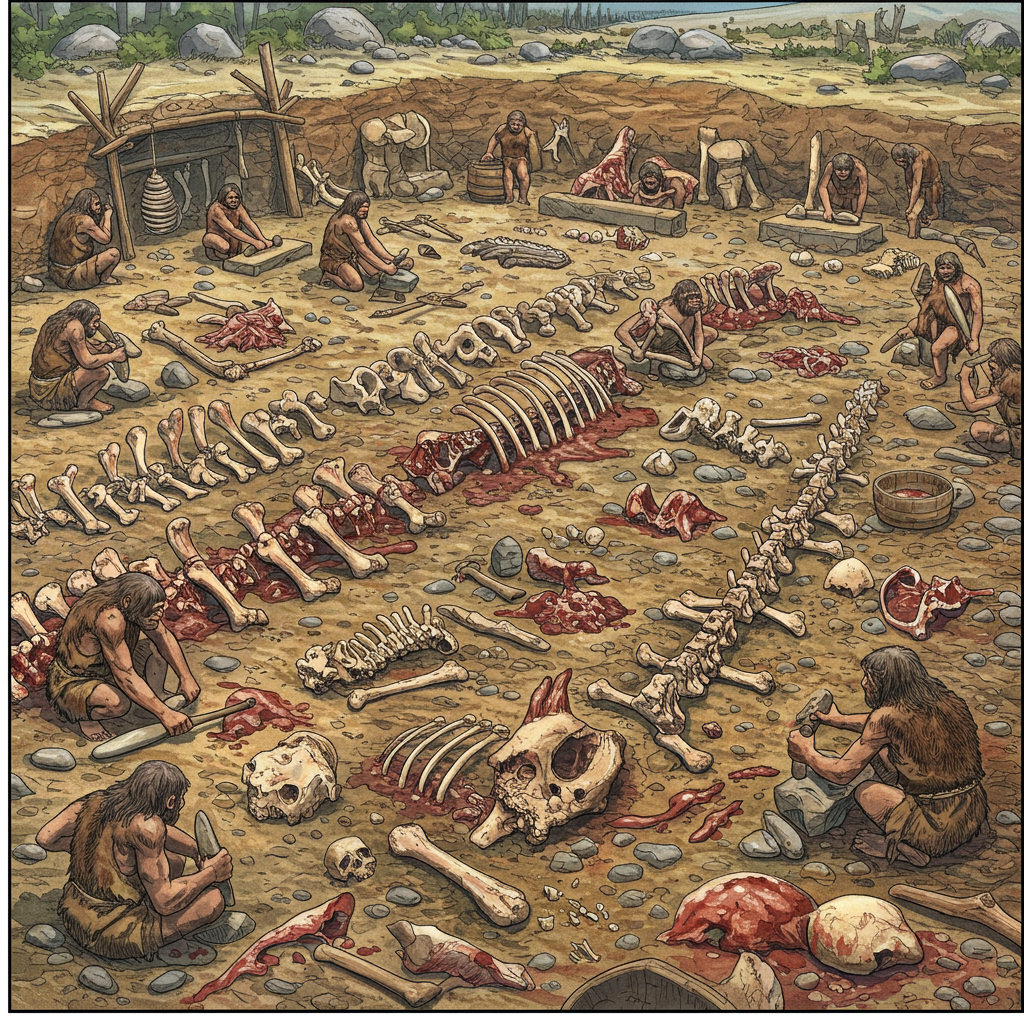Prepare to rethink everything you thought you knew about our ancient relatives, the <a href="https://news.quantosei.com/2025/07/06/infographic-who-controls-rare-earth-processing/” title=”Strategic Map: Who Controls Rare Earth Processing?”>neanderthals. A groundbreaking archaeological discovery in eastern Germany is challenging long-held assumptions, revealing a level of sophistication and strategic planning previously attributed solely to early Homo sapiens. Researchers have unearthed compelling evidence of a large-scale operation dating back 125,000 years: a sophisticated “fat factory” where Neanderthals systematically processed animal bones to extract vital nutrients. This site, located at Neumark-Nord near the modern city of Halle, suggests a much deeper understanding of resource management and nutrition than once believed.
Unearthing a Prehistoric Industry
The scale of the finding at Neumark-Nord is extraordinary for its age. Within a relatively small area, archaeologists uncovered over 100,000 bone fragments. These remains belonged to at least 172 large mammals, including red deer, horses, and aurochs. The sheer volume and concentration of bones point away from a simple butchery site. Instead, the evidence strongly suggests a dedicated, task-specific area for intensive processing.
The site dates to the Last Interglacial period, a time when Neanderthals inhabited this now-famous German landscape. The broader Neumark-Nord complex, first discovered in the 1980s, is renowned for its exceptional preservation of an entire ancient ecosystem. This preservation allows researchers to see how Neanderthals utilized different areas for specific activities, with this particular spot appearing specialized for bone processing and fat extraction.
The Science Behind the ‘Fat Factory’
How did Neanderthals extract fat from bones? The archaeological evidence provides clues. The found bones were not just scattered remains; many showed clear cut marks and signs of intentional breakage. Analysis revealed that marrow-rich bones were concentrated in specific clusters, further supporting the idea of a designated processing area. The bones had been systematically smashed and crushed, often into thousands of tiny fragments.
Researchers, including lead author Dr. Lutz Kindler from MONREPOS (Leibniz Centre for Archaeology), suggest a labor-intensive two-step process. First, Neanderthals likely broke open bones to access the calorie-rich marrow inside. Then, they would further fragment the remaining bone material into small pieces. These smaller pieces show signs consistent with being boiled. Boiling bone fragments in water causes the fat (grease) to separate and rise to the surface, where it could be skimmed off. Flint artifacts and hammer stones found alongside the bone fragments further support the use of tools for smashing and processing. This deliberate, multi-step method demonstrates significant technical knowledge and planning.
Why Fat Was Essential for Neanderthals
Understanding the Neanderthal diet is key to appreciating the significance of this “fat factory.” While they primarily ate meat, muscle protein alone cannot meet daily energy needs beyond a certain point (around 300 grams per day). Consuming excessive protein without sufficient fat or carbohydrates can lead to a dangerous condition known as “protein poisoning” or “rabbit starvation.”
Fat, by contrast, is incredibly calorie-dense – providing more than double the calories per gram compared to protein or carbohydrates. For a species navigating the challenges of the Ice Age environment, with potentially scarce plant-based carbohydrates, fat was a life-sustaining resource. Extracting bone grease would have provided crucial calories and nutritional balance, especially important during lean times like winter or early spring. This intensive processing also represents a form of resource intensification – maximizing utility from available prey, pushing the known timeline for this strategy back significantly in hominin history.
Redefining Neanderthal Capabilities
This discovery adds substantial weight to the growing body of research challenging the traditional image of Neanderthals as simple, brutish cave dwellers. The operation at Neumark-Nord was “intensive, organized, and strategic,” according to researchers like Dr. Kindler. It involved planning hunts, transporting carcasses or parts, and dedicating a specific location and method solely for fat rendering. This suggests a level of planning, resource management, and task specialization previously often thought unique to Homo sapiens.
Evidence of potential caching of carcass parts for later processing at the site even opens the possibility of food storage, a behavior requiring forward thinking and delayed gratification. This aligns with other recent findings suggesting Neanderthals were capable swimmers, used complex adhesives like birch bark pitch, cared for their vulnerable, and potentially used speech. The “fat factory” further paints a picture of an intelligent, adaptable, and resourceful species capable of complex strategies for survival and maximizing nutrition.
A Unique Window into the Past
The exceptional size and preservation of the Neumark-Nord site complex are invaluable to understanding Neanderthal behavior and their environmental impact. As computer scientist and data manager Dr. Fulco Scherjon noted, such preservation for a site of this age is incredibly rare. Studying distinct activity zones within the same landscape, like the fat processing site, allows researchers to gain a comprehensive view of how Neanderthals lived and interacted with their environment, including its flora and fauna. This site not only transforms our understanding of Neanderthal diet and technology but also opens exciting new avenues for research into prehistoric ecosystems and hominin behavior.
Frequently Asked Questions
What exactly is a “Neanderthal fat factory”?
A Neanderthal “fat factory” refers to an ancient archaeological site, specifically Neumark-Nord in Germany, dating back 125,000 years. It’s called a “fat factory” because evidence indicates Neanderthals used this location primarily and systematically to process large quantities of animal bones. Their goal was to extract fat, both marrow from inside the bones and grease rendered by boiling bone fragments. This was a dedicated site for resource intensification.
Where was this site found and how did they extract the fat?
The site is located at Neumark-Nord in eastern Germany, near the city of Halle. Archaeological findings show Neanderthals used tools like hammerstones to smash bones from animals like horses and deer. They likely first accessed bone marrow. Then, they further fragmented the bones and likely boiled these fragments in water. This process caused the bone grease (fat) to float to the surface, allowing them to skim it off for consumption.
How does this discovery change our view of Neanderthals?
This finding significantly challenges the traditional stereotype of Neanderthals as primitive. It reveals a level of complex planning, organization, and resource management previously thought unique to Homo sapiens. Systematically processing bones for fat requires technical knowledge, foresight, and potential cooperation. It demonstrates they understood nutrition, used their environment efficiently, and could engage in labor-intensive activities for long-term benefit, painting a picture of a highly intelligent and adaptable species.
Conclusion
The discovery of the 125,000-year-old “fat factory” at Neumark-Nord is a pivotal moment in understanding Neanderthals. It provides compelling evidence of sophisticated resource management, strategic planning, and a deep understanding of nutrition. This prehistoric industry not only supplied vital calories but also highlights the ingenuity and adaptability of a species that thrived for hundreds of thousands of years. As archaeologists continue to explore sites like Neumark-Nord, the picture of Neanderthals that emerges is one of complex, capable individuals, much more like us than previously imagined.




